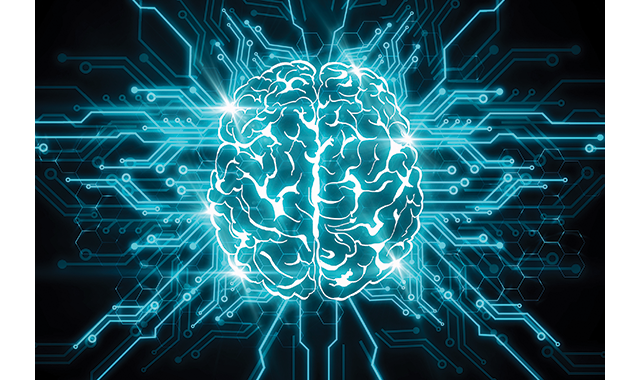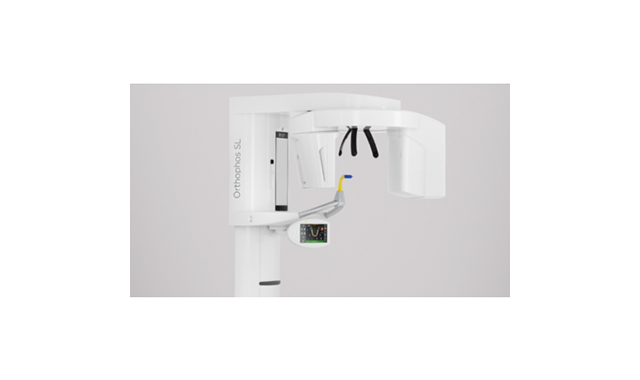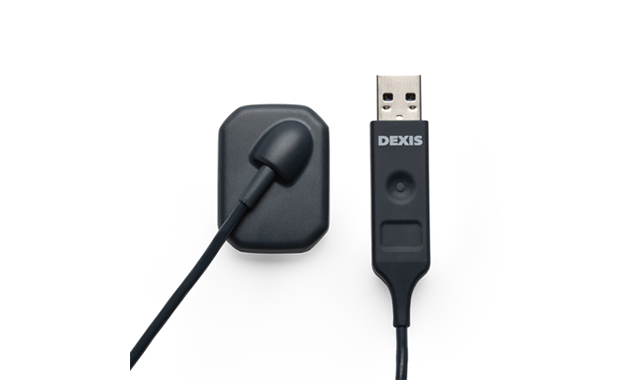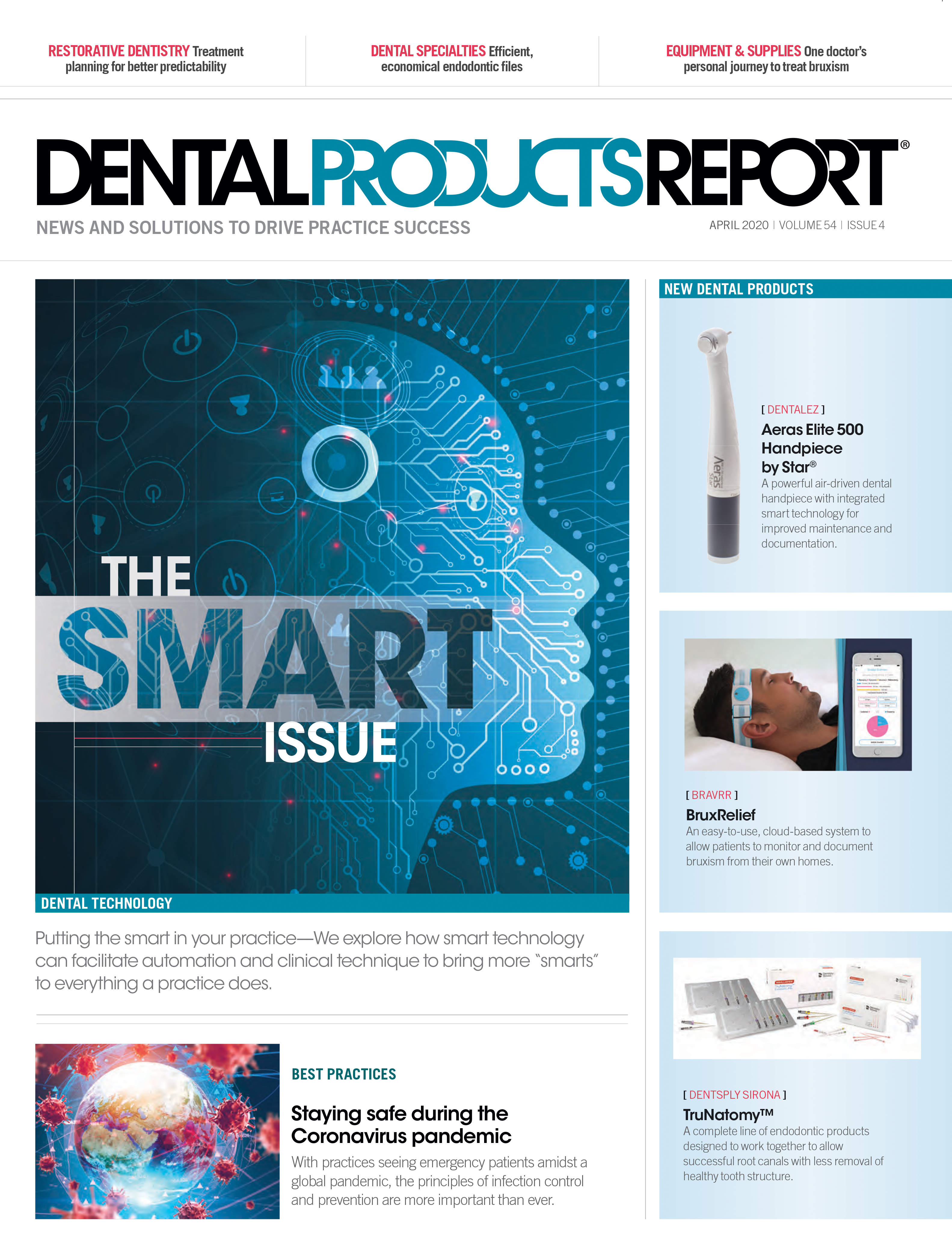Smart—and getting smarter all the time
How smart technology is changing the dental care landscape.

Dr. John Flucke

Smart tech surrounds us on a daily basis. I go to sleep listening to white noise broadcast from my Amazon Echo to my Bose Bluetooth speaker on my bureau. I wake to an alarm from the same Amazon Echo. I stumble out of bed to pour my first cup of coffee, which has finished brewing 15 minutes before my alarm goes off. Five minutes before I am ready to leave for the office, Siri places my order for Starbucks (I know, I consume too much caffeine). Two minutes before I walk out the door, Alexa tells me about the traffic on my commute and the anticipated travel time, and that’s all before my workday gets started.
I’d be willing to bet that many of you have more technology driving your morning than what I just listed. We are now living in a world of smart devices that take care of us.
From Nest thermostats to Ring doorbells, we are living in the IoT, or the Internet of Things. Our homes have become technology platforms and in the past 10 years our vehicles have definitely become technology platforms. The exponential growth of devices and technologies has completely changed how we interact with our environment.
The question for this month’s column, and one you may also be asking, is: But where is all of this IoT tech in the dental office? That’s a great question and one I’ll attempt to answer.
In today’s tech environment, the smart home is a real thing. New construction can include systems that do almost anything you can imagine; controlling lights, temperature, door locks, garage door openers, and CCTV cameras. Then add in options such as motorized window treatments, multi-room audio, and multi-room video.
It’s truly like something people envisioned in science fiction in the ’60s. However, for dental offices, I think the short answer is that we aren’t at the point of a truly integrated smart office. Yet.
Development in dentistry always seems to go through a creation phase, which is when individual products are developed and the bugs are worked out. When the technology reaches a critical mass in the market, it then becomes something that we as a profession use on a regular basis and many offices find they can’t do without.
After reaching this point, offices begin to look for ways to integrate these technologies and create a smooth digital workflow. The workflow piece is essential when offices find that these technologies have become mission critical.
To improve and simplify these processes into a truly digital workflow, the creation phase is followed by the integration phase. This is when multiple technologies converge and can work together - think of digital radiography and intraoral cameras. These were both standalone systems when they were created.
However, when computers began to appear in the operatory these two standalone technologies were suddenly connected into a smooth digital workflow via the operatory computer. We went from two cart-based systems that were wheeled around the office to a clinical work flow that was always there, always on and easy to use.
The Orthophos SL from Dentsply Sirona is a CBCT system capable of 3D imaging, a technology that opened new possibilities in diagnostics and treatment planning.

The current state of the smart office is in the creation phase. The last integration phase stalled when dentistry entered the world of 3D. Cone-beam computed tomography and chairside digital impression/scanner systems required their own computers and high-end graphics capabilities. The hardware was expensive and would have required new computers in every operatory just to view CBCT scans.
The good news is that creation means innovation and that translates to new and exciting things to improve patient experiences and clinical outcomes.
So, let’s take a look at some of the devices that will change our practices and improve our digital workflows as the next phase of integration takes place.
Artificial Intelligence
Machine learning is real and it’s changing the world we live in. Society’s current focus on security against terrorism has created a world where cameras are ubiquitous. A quick internet search brought up estimates that the average American is photographed between 40 to 70 times per day.
Now, before we go down the rabbit hole of living in a surveillance state, let’s look at the positive of this. Whenever technology advances, smart people will figure out a way to take the glut of it and repurpose it into other technologies.
The reason that we have such a huge consumer drone market is because of the glut of parts created by the cellphone market. Manufacturing processes became more efficient, prices fell, and now I’m running my quadcopter on autopilot with the crash avoidance capabilities of a Tesla.
Humans can’t analyze all that photographic digital data. Facial recognition software was one innovation to handle the multitude of digital images. The trickle-down effect is tremendous advances in artificial intelligence (AI) have been made and those algorithms are being applied to dental radiographs. There are several companies that are training AI programs to identify caries, bone loss, periapical pathologies, you name it.
These systems will not be making a diagnosis instead of the doctor. Rather, they will offer objective second opinions that allow the doctor to have more data points to better make diagnostic decisions.
The other advantage of AI is that as the doctor works with the system and corrects any errors it makes, the system learns (hence the term machine learning) and the system improves at indicating areas of concern. Soon, these algorithms will be examining radiographs once they are taken. This will help diagnostic accuracy and also improve patient communication as patients have more than just the doctor’s opinion.
Continue reading on the next page...
Connected equipment and hardware
The average new automobile now has between 25 to 50 central processing units running all kinds of functions in the vehicle. With all of that computing going on, how does the service technician know what the problem is? The technician plugs a small device into the vehicle and those CPUs provide a report to the technician showing what, if any, functions are out of the proper parameters.
Romexis Clinic Management software from Planmeca connects dental units with software and allows those units to communicate to the practice itself.

Dental offices are now entering that realm as well. Just as some homes are referred to as “connected homes,” there is now the ability to create the connected dental office. Programs such as Romexis Clinic Management software from Planmeca connect the dental units with software and allow those units to communicate back to the practice with all kinds of statistics on usage, number and type of radiographs taken, milling jobs, and maintenance.
The system also allows employees to log into their units via key cards that set the operatory up with the user’s preferences with things such as patient chair position, etc.
There is also a Romexis Imaging module that brings 3D, 2D, and digital impressions all into one program. It allows for all of these completely different data sets to be merged into one continually updating 3D patient. This allows for incredibly complex treatment planning with amazing features such as virtual articulation right on the screen.
There are also internet-connected devices, such as the Statim G4 autoclave from SciCan. This is the world’s fastest cassette autoclave from start to sterile. In addition to the speed, the Statim G4 is also internet connected. The device is Wi-Fi compatible and sends data on sterilization cycles to devices or computers so that the person in charge always knows that everything is correct.
The Statim G4 autoclave from SiCan is Wi-Fi compatible and sends data on sterilization cycles to other devices or computers.

If there is a problem requiring service, the Statim G4 will send an alert to your service technician, who will know what the problem is before they walk into the office. This eliminates the need to repair an autoclave off-site and helps increase device uptime as well.
Motion sensing radiography
Earlier, I mentioned how excess inventory from the cellphone manufacturers helped bring the drone evolution to market, but something else has benefitted from that industry-intraoral radiography.
The DEXIS Titanium sensor from KaVo Kerr has an accelerometer built into its hardware. That chip senses motion in your cellphone and changes the screen view as you rotate it. Because of that little chip, the sensor can detect movement.
The smart folks at DEXIS took advantage of this by building in the ability of their software to communicate with the sensor that allows the operator to tell the software what kind of X-rays are being taken by moving the sensor in certain ways. This is tremendous for infection control because it allows the operator to take images without having to use a mouse or a touchscreen.
I’m looking for other devices with motion sensing technology to show up in future generations of many of the hardware devices we use.
On the horizon
The DEXIS Titanium sensor from KaVo Kerr has an accelerator built into its hardware, which can sense movement and allows the device to communicate with its software.

I cannot discuss all of the latest connected devices I’ve seen lately due to nondisclosure agreements that I’ve signed, but please trust me when I say the best is yet to come. In the past nine months or so, I have seen some incredible things that have the potential to truly change the way we practice. One of the things I love about our profession is the passion that everyone in the field has for what we do. Scientists, chemists, engineers, physicists, business leaders, and employees in the office with us are just a small sample of the number of people who affect the lives of patients for the better.
As things progress, we are going to see another integration phase and what that leads us to is going to be phenomenal. This is going to be fun!
